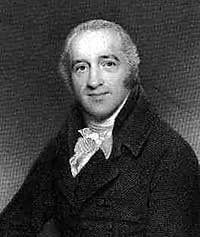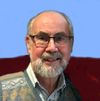Cambridge was a dark place, both spiritually and literally, in the latter half of the eighteenth century. There were no street lamps, the roads were potholed, and only the college buildings were of any note.
John Wesley only mentions it once in his Journal, a reference to 11 October 1763: ‘I rode through miserable roads to Cambridge, and thence to Lakenheath’ – and thus the Great Awakening passed it by.
Religion was formalistic and increasingly rationalistic. Incumbents were so often absent from their pulpits that University Fellows rode out on Sunday mornings to provide three or four services at various churches in succession. Churchwardens would raise a flag if no congregation had assembled and the riders would gallop on to the next church.
There was, however, a small Baptist congregation of 34 members meeting at the Stoneyard Church (now St Andrews Street Baptist Church) who called Robert Robinson (1735-1790) to be their pastor.
He arrived in 1761 and soon had to rebuild the Old Meeting House to accommodate the numbers, which grew to 500-700 by 1774. He was popular with some of the students, but his later association with Unitarians caused disquiet.
A more substantial ministry was required, and the year 1759 was quite auspicious in this respect, marking as it did the birth of future Cambridge graduates John Venn (1759-1813), William Wilberforce (1759-1833) and Charles Simeon (1759-1836).
Eton and King’s College
Simeon was from an upper middle-class family and attended Eton from the age of nine to nineteen. He was agile enough to leap over a row of six chairs, and was a skilled horseman, but no academic distinction is recorded.
Vices abounded and he later recorded that it cost no small sum to rectify his misdeeds. Yet he was singular in keeping an alms-box in which he put money to ease his conscience when he knew he had done wrong.
Before the 1860s, King’s College was reserved for elected scholars from Eton, and he arrived there on 29 January 1779. On being informed that it was compulsory to receive Communion in the chapel, he later wrote, ‘the thought rushed into my mind that Satan himself was as fit to attend as I; and that if I must attend, I must prepare for my attendance there’.
Seeking and finding
Simeon first consulted The whole duty of man (1658) – the only religious book he had ever heard of. He then struggled with conviction of sin for three months, until he turned to a book by Bishop Wilson on the Lord’s Supper.
He read that ‘The Jews knew what they did when they transferred their sin to the head of their offering’ – and he realised that he could gain salvation by transferring his sins to ‘the sacred head of Jesus’.
The burden of his guilt rolled away and he awoke on Easter Day 1779 with the words upon his heart and lips: ‘Jesus Christ is risen today; Hallelujah! Hallelujah!’.
The brilliant and evangelical Isaac Milner (1750-1820), who was instrumental in Wilberforce’s conversion, was tutor at Queen’s College, but Simeon was virtually unaware of any other Christians in the college during his three undergraduate years. Just as Paul ‘did not consult any man’ after his conversion (Galatians 1:16-17), so Simeon established his faith mainly through his own devotional studies.
Spiritual disciplines
Simeon rose at 4.00am for private prayer, self-examination and Bible reading – seeking to mortify weaknesses such as his quick temper and extravagant dress habits. Later at 8.00am he summoned his servant to join him in prayer.
From the outset he arranged a time on Sunday evenings for instructing the domestic staff who were unable to attend morning worship, there being no parochial evening services. In the summer vacation, he instigated prayers for his own household.
He set aside a part of his small income for the Lord, and by careful stewardship finished his three years of study without owing a shilling, whereas his fellow students owed several hundred pounds.
A herald for God
Early in 1782, Simeon attended St Edward’s Church, where Christopher Atkinson of Trinity was vicar. Atkinson introduced Simeon to John Venn of Sidney Sussex College, the future Rector of Holy Trinity, Clapham. He took him to see his godly father, Rev. Henry Venn (1725-1797), Rector of Yelling. Simeon often travelled the 12 miles to enjoy mutual fellowship.
Atkinson appointed Simeon to minister during the long vacation, and he soon filled the church to overflowing. Henry Venn remarked, ‘Oh, to flame as he does with zeal and yet be beautified with meekness!’
Passing Trinity Church, Simeon had previously thought, ‘How should I rejoice if God were to give me that church, that I might preach the gospel there and be a herald for him in the university’. It seemed an impossible dream, but the unexpected death of Trinity’s minister resulted in the Bishop of Ely appointing him initially as curate-in-charge.
Opposition
The churchwardens, furious that their preferred choice was rejected, mounted a vigorous opposition for over twelve years. The pew-doors were locked so that people had to stand in the aisles.
Simeon personally financed the purchase of benches and seats, but these were thrown out. He tried to start Sunday evening services, but the church doors were locked. He once hired a locksmith to open them, but then desisted – ‘The servant of the Lord must not strive’ was the text that kept his zealous anger in control.
The corn famine of 1788 made bread too expensive for the poor, so Simeon organised a local subscription and personally rode out to twenty-four villages to make sure bread was being sold at half-price, the balance funded by himself.
University colleagues commented, ‘He means well at least; this is not like madness’. Yet adherents still received the opprobrium of ‘Simeonites’ or ‘Sims’ into the next century.
Preaching
Simeon is best known for his instruction in the art of preaching and biblical exposition. From the 1790s he instructed potential candidates for the ministry privately in his rooms with ‘sermon-classes’ and, from 1812, ‘conversation-parties’.
One student was Henry Martyn (1781-1812), who served as Simeon’s curate at Holy Trinity. Martyn went to India where he translated the Bible into Arabic, Persian and Urdu – eventually dying of fever in Turkey.
Simeon preached from every book in the Bible, and his 2536 outlines were published in 21 volumes as Horae Homileticae (1819-1828), which he was able to present to King William IV in 1833.
In the preface he asked of a sermon: ‘Does it uniformly tend: To humble the sinner? To exalt the Saviour? To promote holiness? If in any one instance it loses sight of any of these points, let it be condemned without mercy’.
He noted, ‘A sermon should be like a telescope: each successive division of it should be as an additional lens to bring the subject of your text nearer and make it more distinct’. He objected to the artificially solemn ‘pulpit voice’ of his day, preferring a natural intonation, rich but not loud, and clear diction.
Simeon’s legacy
Simeon made a bold stand for evangelical Anglicanism – his authority was first the Bible, then the Liturgy, then all other books. He helped found the Church Missionary Society (1797) and his example led to the founding of the Cambridge Inter-Collegiate Christian Union (CICCU) in 1877.
Norman Grubb (1895-1993) of Trinity had a vision in 1919 to see an ‘evangelical witnessing community on every university campus’ in Britain, which led to the formation of the Inter-Varsity Fellowship in 1928 (now UCCF). Today about 20,000 students are involved in over 350 CUs across the UK.
Simeon was celibate and endured persecution and suspicion from colleagues without a wife’s comfort, but rejoiced because he ‘had been counted worthy of suffering disgrace for the Name’ (Acts 5:41).
John Piper observes that we are ‘surrounded by a society of emotionally fragile quitters, and we need to spend time with people – whether dead or alive – whose lives prove there is another way to live. [We ought to] “be imitators of those who through faith and patience inherit the promises” (Hebrews 6:12)’.
As Simeon lay dying in October 1836, a friend sat by his bed and asked what he was thinking of just then. He answered, ‘I don’t think now; I am enjoying’.
Sources
Nigel Clifford, Christian preachers (Evangelical Press of Wales, 1994, pp. 180-188).
Leonard W. Cowie, ‘Charles Simeon (1759–1836)’ in The Oxford Dictionary of National Biography.
David Goodhew, ‘The rise of the Cambridge Inter-Collegiate Christian Union 1910-1971, Journal of Ecclesiastical History, January 2003.
Handley Moule, Charles Simeon – Pastor of a generation (Christian Focus, 1997).
John H. Overton, The English Church in the Nineteenth Century (1800-1833), (Longmans, 1894).
J. I. Packer, ‘Expository preaching: Charles Simeon and ourselves’, Churchman 074/2 1960; from http://www.churchsociety.org/churchman/documents/CMan_074_2_Packer.pdf.
John Piper, ‘Brothers, we must not mind a little suffering; Meditations on the life of Charles Simeon’, 1989 Bethlehem Conference for Pastors; from
Charles Simeon, Let Wisdom judge (IVF, 1959) from
UCCF: http://www.uccf.org.uk/about-us/our-story.htm
Nigel T. Faithfull




